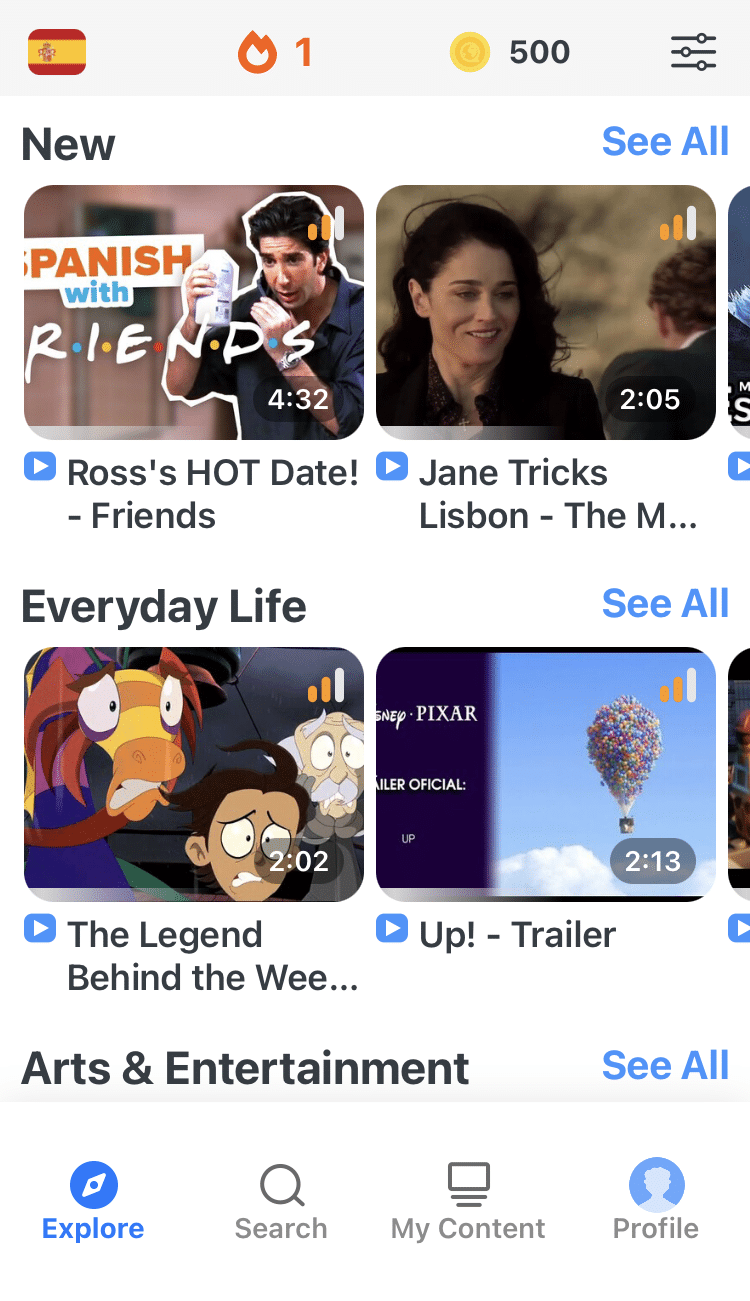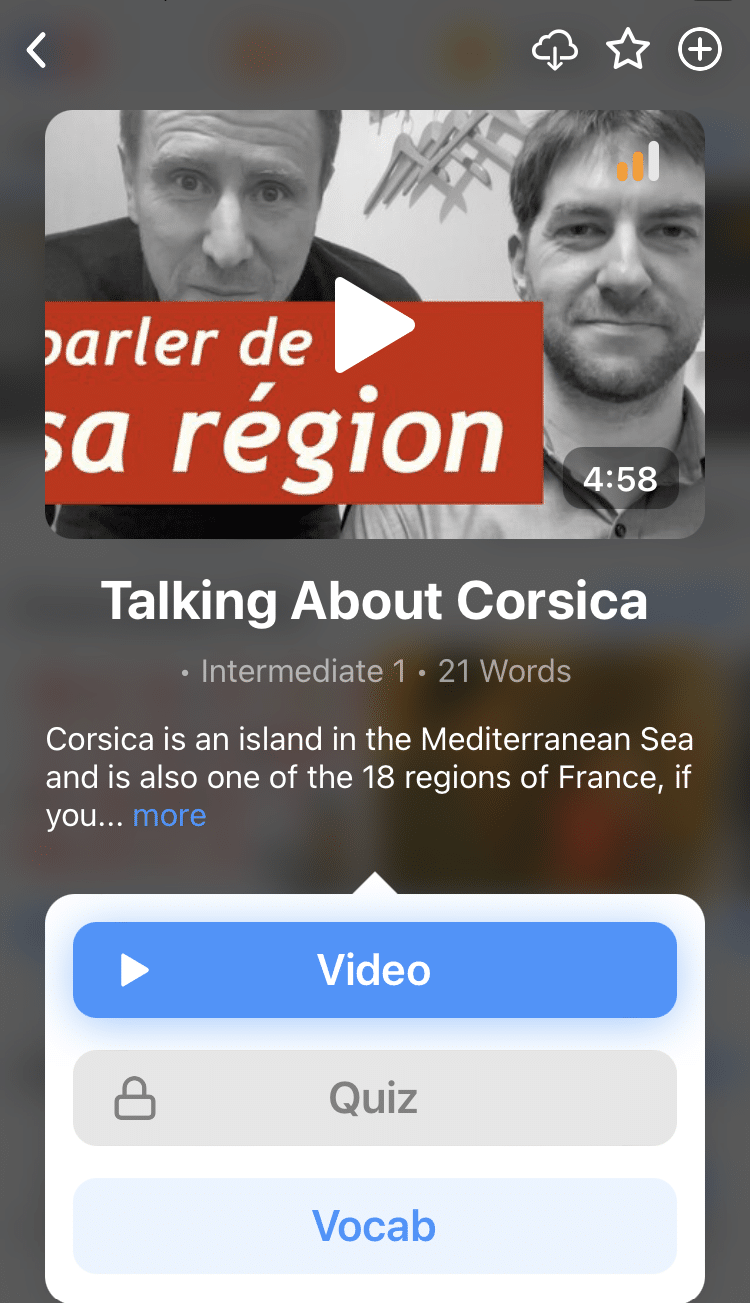
How to Learn a New Language Faster
Learning a new language doesn’t need to be a slow or tedious process.
I’ve studied five languages while living in four different countries. Although nothing can replace the hard work and effort it requires, it’s definitely possible to speed up the process!
Follow these 23 tips on how to learn a new language fast, and you’ll be on your way to mastering that new language quicker than you ever imagined.
Contents
- 1. Set language-learning goals
- 2. Learn the “right” words
- 3. Use flashcards
- 4. Study smart
- 5. Think in your target language
- 6. Start using the language all day, every day
- 7. Pick a word from the day
- 8. Get plenty of comprehensible input
- 9. Watch movies and use subtitles
- 10. Listen to music and learn the lyrics
- 11. Multitask for more exposure
- 12. Read local literature
- 13. Seek out real-life practice
- 14. Make friends with native speakers
- 15. Learn about the culture
- 16. Consider investing in tutoring
- 17. Test yourself
- 18. Plan a virtual trip
- 19. Travel and immerse yourself
- 20. Learn from every mistake
- 21. Practice with your pet
- 22. Play games using your target language
- 23. Make a connection with food
- And One More Thing...
Download: This blog post is available as a convenient and portable PDF that you can take anywhere. Click here to get a copy. (Download)
1. Set language-learning goals
The first step to learning a new language fast is to set goals for what you want to achieve.
When faced with the idea of learning a new language, most of us feel overwhelmed. There are so many words to learn and so many different ways to study.
Research shows that people who set the right kind of goals are more likely to achieve success. Setting goals narrows your focus so you can stop worrying about the details and get down to business.
Use these guidelines to get the most from your goals:
- Set short-term goals. It’s good to have an ultimate goal—the thing you eventually hope to achieve. But long-term goals are too overwhelming to motivate you on an everyday basis. Break down your ultimate goal into smaller bits, and set smaller goals for each week or month.
- Challenge yourself (but not too much). Goals work best when they make you push yourself. If they’re too daunting, they can actually discourage you.
- Focus on specific, tangible outcomes. Set detailed goals, and focus on what you plan to learn rather than how much time you plan to study. An example of a good goal might be, “This week I’m going to learn 30 Spanish vocabulary words related to shopping.”
- Write down your goals. Writing down goals helps you commit to them. Post your goals in a prominent place, like your bathroom mirror or the home screen of your smartphone.
2. Learn the “right” words
Strategize and prioritize your learning by focusing on what matters.
The exact amount may differ, but for many languages you need between 1000 to 3000 words to be conversational. So why waste time trying to learn more words, especially at the very beginning?
Identify what words, phrases and expressions will get you the most bang for your buck, and work from there. You can start with practical, colloquial topics then work your way up from there.
Also check out these lists of the top 1,000 words in these languages:
By focusing on learning these words first, you can eliminate wasted time and increase the amount of information you understand very quickly.
3. Use flashcards

When learning your words, you’ll learn faster by using the very best study techniques, such as using spaced repetition software (SRS).
For example, one of the best ways to do this is to use flashcards. Flashcards help you focus on individual words and allow you to test yourself, which helps you memorize new information.
When you learn with flashcards, follow these tips to learn fast:
- Try out electronic flashcards. Paper flashcards work just as well as they ever did, but with digital flashcards, you can easily carry large stacks on your smartphone or tablet. You can also take advantage of flashcards that other people have created and made public.
- Make sure to guess the meaning of a word before turning over the card. Flashcards work best when you use them to test your memory, so don’t be too quick to flip the cards over. Even if you don’t know a word, make a guess.
- Learn the translations first, then learn to produce the new words. Start by looking at the side of the flashcard with a foreign word on it, and memorize what the English translation is. Later, turn the cards over and use them to practice producing the foreign words when you see their English equivalents.
Practice makes perfect, but effective practice makes perfect even faster!
4. Study smart
Some more great strategies for integrating new words alongside and beyond flashcards include:
- Visualize and vocalize. Visualize the word you’re learning, imagine the image of what it represents and say the new word aloud. This helps you connect the concepts and can improve memorization.
- Gesture. The brain learns better when you use physical actions while learning. Take advantage of this by gesturing. If you want to learn the German word Schuh (shoe), say the word while you pretend to put on a shoe.
- Talk when you read and write. It will help you remember faster if you vocalize your target language. Read anything that you read or write out loud and try to mimic the accent of a true native while doing this. Remember that the goal is to eventually speak, so this step is important!
- Use mnemonic devices. Make up a sentence with the new word you’re learning, the meaning of the word and a word in your native language that sounds similar. For example, if you want to learn the Spanish word mesa (table), you could make up a sentence like, “My kitchen table is always a mess!”
5. Think in your target language
People say you’re not fluent in a foreign language until you catch yourself thinking in it. That makes sense.
Thinking directly in your target language as much as possible will help you avoid errors and speed up the learning and speaking process. It could also help you avoid confusion in the middle of a conversation.
If you do need to translate, be strategic about it. Referring to the languages that you already know and using translation can be used to your advantage, but there are ways to do it efficiently and correctly.
What you could do is think about all the short and simple sentences you use in your daily communication. What sentences do you need at the grocery store? At the post office? At work? At home?
Use a trusted resource for your sentences so that they’re guaranteed to be correct. Learn how to say them, and then always think them to yourself as you go about your daily business.
6. Start using the language all day, every day

As a beginner, it can seem overwhelming to try to use the language all day, but it’s not as difficult as it seems. There are many easy and even fun ways to make the language a part of your regular life.
You can use your normal everyday activities as part of your language learning process.
- Make use of every moment you have to learn new words. Take flashcards with you, and study them during your train or bus commute (but not while driving, please!) or when you’re waiting to meet a friend.
- Switch your cell phone to the language you are studying. You can also do this with your other devices or social media accounts.
- Immerse yourself in the language at home by designing your home environment so you’ll be surrounded by the language. For example, you can place pictures of vocabulary words you want to remember at the walls of your home or even write grammatical rules.
You might also want to consider checking out Olly Richard’s language courses, which helps solve the commitment problem by walking you through the immediate concerns of learning a language to fluency.
7. Pick a word from the day
Let’s say you want to learn German:Track down a handful of new German words you’d like to learn. Write one word per piece of paper, including its translation, pronunciation, part of speech and sample use in a sentence—basically, a dictionary entry.
Pick common nouns, verbs, adjectives and prepositions that you need to know. Your pool might contain: stehen (stand), laut (loud), bekloppt (crazy) and auf (on). Keep these little papers in a bowl near your bed.
Every morning when you wake up, pick from the set. That lucky word will be the one you’ll practice all day long. Use it in conversations with dogs, Facebook chats and comments, in your journal, etc. Use it 15 times at least!
This repetition will store the word in your long term memory. For more effective results, incorporate past words-of-the-day in your activities so you can keep everything fresh in your mind.
8. Get plenty of comprehensible input
When you start to feel tired, switch from active learning to passive learning by doing what you would normally do in your native language in your target language. In other words, take in comprehensible input.
Comprehensible input means material in your target language that you can understand–but it’s still slightly above your level because there are some words or grammar concepts that you don’t know.
According to one of the most influential theories in linguistics, getting comprehensible input is how people acquire and become fluent in a language. To get good at a language fast, you’d want to get a lot of comprehensible input (listening and reading), especially at the start.
This is pretty fun to apply because input can mean TV shows, comics, online videos, podcasts or even actual conversations that you overhear in your target language. Keep reading for tips on how to use these resources in the best way!
The catch is that they have to be comprehensible, though. If you watch a movie without understanding the lines at all, take it down a few notches and choose easier material!
This video explains how comprehensible input speeds up the language learning process:
9. Watch movies and use subtitles
This is the time for movies and video content to make an appearance in your language program. They’re a great example of comprehensive input. Plus to make studying fun, bring in some resources that you actually enjoy!
It might seem like a time-waster but I assure you, it’s not. Netflix is a pretty good source for movies across different languages.
Think of all of the idioms, conversational phrases and essential vocabulary that show up in them. Aside from being interesting, they also immerse you in the culture.
There are a few phases in watching a foreign movies if you want to maximize their potential for language learning:
- First, watch the movie or one scene while reading the subtitles. If there’s a word you don’t understand, write it in your personal dictionary and define it.
- Pronounce those words and try to get the accent right. If you can, fit them into sentences of your own, so you’ll understand how they can be used in different situations.
- Now, watch the movie or scene again without the subtitles. It’s important to understand as much of the speech as you can. That way you can take your listening comprehension and fluency to the next level.
FluentU takes authentic videos—like music videos, movie trailers, news and inspiring talks—and turns them into personalized language learning lessons.
You can try FluentU for free for 2 weeks. Check out the website or download the iOS app or Android app.
P.S. Click here to take advantage of our current sale! (Expires at the end of this month.)
10. Listen to music and learn the lyrics
If you love listening to music and do it anyway, why not listen to it in your target language! Words tend to flow more naturally when you sing, and singing makes it easier to get the pronunciation right.
Music is also fun because it’s a direct line to the culture you’re learning about. Of course, you’ll need to choose music with lyrics if you’re trying to work on your fluency. Find the lyrics online and try to sing along.
Thanks to amazing websites like Genius, lyrics of any song in any language are usually available—along with lyric meanings, translations and romanized versions (if necessary).
It doesn’t matter whether you have a talent for music or are completely tone deaf. The only important thing is to follow the flow of the words. There’s nothing more fluent than the way words connect through song.
11. Multitask for more exposure
You’re gonna be doing other things at home, right? You could be doing aerobics exercises or cleaning your car. Why don’t you incorporate language into these affairs?
- Exercise body and brain. You could be doing you usual aerobics in Italian, for example. Get some Italian aerobics tapes or find videos on YouTube. Instead of counting “one, two, three,” you’ll be puffing “uno, due, tre.“ Instead of moving left and right, you’d go sinistra and destra. The added advantage of this is that, because you’re using new words in a specific context, you’ll find the words easier to remember.
- Keep your target language in the background. While cleaning your car or cooking, listen to language lessons or podcasts. This way, you’re hitting two birds with one stone. If you could listen to lessons that talks about what you’re doing at the present (like cooking), then so much the better.
Multitasking and incorporating your target language frees you from the excuse of being “too busy” for a second language.
12. Read local literature

Reading to further your language skills is another great strategy. It helps you with vocabulary, grammar, sentence construction, and is also a great way to further your cultural knowledge.
Miguel de Cervantes wrote in Spanish, Italy has Dante, Hugo presented the sophistication of French expressions, and the great Tolstoy and Dostoevsky revealed new dimensions of the Russian language.
If advanced novels and books are too daunting for you now, try learning with bilingual books, children’s books or books designed for language learners.
13. Seek out real-life practice
Get talking right away, from the very early stages of your language learning journey! Some of the best learning happens in real-life situations, particularly when you have no choice but to use a foreign language.
This is the favorite approach of organizations like the Peace Corps, which regularly places people with little or no knowledge of a language into full immersion situations.
Although such situations can be uncomfortable, they provide enormous motivation to learn quickly.
Even without traveling abroad, you can immerse yourself in real-life situations that give you loads of language practice. Try these options:
- Find a language learning buddy. You can talk in the foreign language and correct each other when needed. You can also make plans and set goals together, increasing your level of accountability and keeping you on track toward fluency.
- Meet with a language partner weekly or biweekly. Practice with a language exchange partner by exchanging half an hour in the language you want to learn for half an hour of speaking English (or other languages you’re fluent in).
- Join a conversation club. Many cities and schools have conversation clubs where language students meet regularly to practice having informal discussions in their target language.
- Use a language partner site. Sites such as Speaky, HelloTalk or Tandem can introduce you to people who speak the language you want to practice. Even if you don’t see them in person, you can gain real-life language practice by chatting online.
- Volunteer with immigrants in your city. Find volunteer opportunities on a site like VolunteerMatch or Idealist, or directly contact organizations that serve immigrants who speak the language you want to learn.
- Visit businesses where people primarily speak your target language. Perhaps there’s a Mexican restaurant nearby where you can practice your Spanish with the owners, or a grocery store that sells food to the local Chinese community where you can practice Mandarin.
14. Make friends with native speakers

Open your house to friends and acquaintances who speak your target language. If you don’t have any, go to language clubs and cultural organizations to make new friends who fit the bill. Invite them for dinner or a coffee. You’ll learn much more from a native speaker than anywhere else.
Native speakers can give you insights into the language and culture you’re interested in. They have firsthand experience. They know the do’s and don’t’s. They know what it’s like to be on the other side of the fence, too.
Don’t be surprised if you’re getting more than a language lesson over dinner. You’ll get to hear great stories from their home country, little-known facts about their culture and tips on linguistic nuances that only come from knowing the language in the real world.
15. Learn about the culture
Understanding a language is about more than understanding words on a page. It’s important to learn about the culture and history associated with these words.
Knowing something about a country or culture’s history, current events, religious beliefs and common customs can help you understand a lot about what people say and do.
Researchers have found that children learn to read in a second language better when they understand the culture and context behind the pieces they read.
As you begin to study a new language, take some time to learn about the culture of the people who speak that language.
Don’t feel this is a waste of time, even if it involves reading and watching videos in your native language. It will help you enormously and can even prevent you from making embarrassing and potentially offensive mistakes.
16. Consider investing in tutoring

While it’s great that there are so many free language-learning options available, if you’re trying to learn the most in a time crunch, you may need to make an investment.
- Hire a tutor. This is a good option for getting on the fast track to language success. Look for qualified tutors at universities and colleges, on Craigslist or even on the message boards in local businesses.
- Do tutoring online. Don’t want to leave your home? No problem: There are plenty of online tutoring services you can turn to.
- You could also pay for a course, subscribe to a learning service or take classes on the side. Whatever fits your goals, budget and time availability!
Also, remember to interview any potential tutors to be sure you’re finding the right person for the job. Discuss price, scheduling and language qualifications.
We wouldn’t expect professional services for free. We shouldn’t necessarily think language learning should be gratis, either.
By investing in a professional and high-quality learning resource, you’ll be giving yourself the best chance at learning effectively and quickly.
17. Test yourself
Knowing that you plan to take a test is a great way to motivate yourself to learn faster. Try to regularly test yourself in little ways or even prepare for some bigger exams.
- Take practice tests or complete the exercises at the end of each chapter if you’re learning from a textbook. Don’t skip these!
- You can also play online games or take online tests. Online practice tests can be found in almost any language, including French, Spanish, Japanese and German.
- Planning to take a standardized test can also keep you motivated, and having the results can help you “prove” your language level to potential employers, schools or even just yourself.
The ACTFL OPI test is popular in many language-learning circles and widely respected. It tests oral proficiency and provides a score that ranks your level anywhere from “Novice Low” to “Superior.”
Some languages also have a standardized test specific to that language, such as the JLPT for Japanese or the HSK for Chinese. Ask teachers or professionals who know the language what tests they recommend.
18. Plan a virtual trip
Who wouldn’t love to fly off to a country to learn a language? But if you can’t go traveling in real life, there’s no reason you can’t plan a trip.
Virtual travel won’t get you a slice in a Roman pizzeria or a seat in a Munich beer garden but it’ll certainly engage you so well that you’ll want to learn as much about a culture—and language—as possible. And quickly, too!
The key to this strategy is to investigate traveling options as if you were actually going to grab your passport and head to your dream location.
You need to act as if time is of the essence, which makes it imperative that you gather as much information—particularly language skills—as possible.
- Choose the target language and add some authenticity to your planning. And, don’t forget to learn some travel phrases. They’re often part of the country’s webpage.
- Prepare as if you had a one-way plane ticket. Read up on local attractions in the target language. Nearly every country has a webpage and most allow visitors to choose a language for the material they showcase.
- Find a virtual host in the destination country online. Start a friendly chat in the language. Ask questions about the area and its attractions and culture.
Who knows, maybe you’ll be so inspired that you’ll try to make the trip a reality!
19. Travel and immerse yourself

If you’re able to, traveling to a country that speaks your target language remains one of the best options out there to practice and improve your language skills.
- Do an immersion program. Doing an immersion program is a great way to both quickly expand your language knowledge and also get corrected by a teacher in a safe learning environment.
- Go out there and explore the country during your time off. Put the language you’re learning to immediate use when you’re not in the classroom. You’ll meet many native speakers who will be happy to help you learn the language better.
- Try Workaway. If you don’t have the money for an expensive immersion course, doing a Workaway trip is the ideal way to stay with a host family, practice the language and learn about the country in exchange for some weekly work hours.
Traveling is not a simple decision to make, mainly because of the time and money investment involved. However, there’s no goal you can’t achieve with proper planning and budgeting. It will definitely be worth it!
20. Learn from every mistake
If you made it to an environment that allows you to practice your new language, congrats! Now get ready to make a lot of mistakes.
- Leave any desires for perfection and any fears of judgment at the door. It’s best to leave your ego out of the situation when doing something as difficult as learning a new language.
- Keep in mind that many natives will be grateful and appreciative of your attempt to learn such an important part of their culture. Congratulate yourself for even the smallest mistakes because it means you are trying.
- Resist the urge to judge each conversation as a success or failure as you go about your day-to-day life and practice using your new language.
- Approach each interaction as a new opportunity for you to learn something. Even though it’s tempting to be our own worst critic and beat ourselves up for not remembering a particular word or knowing how to clearly express a thought!
Reflect on each conversation and give yourself constructive feedback. Some things you might want to think about are:
- What words/phrases would have served me in that conversation?
- What new words did I hear/see?
- How could I more effectively have a similar conversation in the future?
When you start embracing the ups and downs of the learning process, you’ll better enjoy and appreciate the journey, which sets you up for more learning opportunities.
21. Practice with your pet

You may have taught your best friend a few dog tricks already, but when it comes to learning a new language he has one more trick to show you.
Do you remember how many times you had to repeat command words when you first taught Sparky to do things like fetch or roll over? It took many repetitions before he even noticed that you wanted him to do something.
At first he just looked at you cluelessly. Then at the 10th or the 15th time you mentioned the word “fetch,” he noticed that you had the habit of throwing the ball. Then on the 20th or 30th time, he observed that you wanted the ball back. Then around the 35th time, he started playing the game and began fetching the ball. Guess how many times you had to say “fetch.”
A lot! If you connect this with Psychology studies that point to repetition as one of the main accelerators of learning, you’ll start to appreciate shouting “fetch” to Sparky in a foreign language.
So for example, you can repeatedly tell him “habla” (“speak” in Spanish). Dogs learn commands in other languages very quickly, and he’ll be speaking Spanish too before you know it. Cool, huh?
22. Play games using your target language
If having fun makes for efficient learning, then playing games is a very important language learning tool.
Truth is, there’s an infinite number of games one can play, limited only by your imagination. Let’s look at one game in particular—charades, with a twist.
Let’s say you want to learn French. How are you going to incorporate that in this game?
Simple. Do French charades! (Keep in mind, you’re going to need a few friends for this one.)
Here’s how it works:
- Make a list of 20 common French verbs. Be sure to include key words like danser (dance), nager (swim) and sauter (jump). Write each of them on a small sheet of paper.
- Put the paper into a bowl or hat. If you’ve got enough participants, you can play this with two teams.
- One team member draws from the bowl and acts out the word. The other member has 30 seconds to guess the verb.
- When time expires and the team member fails to give the correct answer, the other team can steal and give one guess. Only one guess is allowed. If the other team guesses correctly, they get the point.
- Then the other team proceeds to take their turn drawing from the bowl and acting.
This game is particularly effective if you’re a kinesthetic and visual learner who remember words better with movement and pictures—that is, you can recall sauter better when you see your partner jumping or feel your own legs springing for a jump.
23. Make a connection with food

Who knew making your own meals could have healthy linguistic consequences?
Getting busy in the kitchen can teach you vocabulary. A big part of cultural identity is food and its preparation. If you open your mind to this, you’ll get to taste language in its most flavorful form. But where will the language lessons come from?
- Cookbooks. Read recipes online or get a cookbook in print. There, you’ll meet food-related Italian words like pesce (fish), manzo (beef), pollo (chicken), al dente (the correct degree to which pasta should be cooked) and antipasto (appetizer).
- Food labels. On labels you might learn the French words arôme (flavoring), eau (water), sel (salt) and oeuf (egg).
- Menus. These provide Japanese words like yaki (grilled), tori (chicken) and yakitori (grilled chicken)
Going to the kitchen and taking a break from your language lessons can be a language lesson in and of itself!
So there you have it! Once you incorporate these into your routine, you’ll be amazed at the progress you make in your language learning. Remember that consistency is key and you’ll be fluent faster than you imagined!
Download: This blog post is available as a convenient and portable PDF that you can take anywhere. Click here to get a copy. (Download)
And One More Thing...
If you dig the idea of learning on your own time from the comfort of your smart device with real-life authentic language content, you'll love using FluentU.
With FluentU, you'll learn real languages—as they're spoken by native speakers. FluentU has a wide variety of videos as you can see here:
FluentU has interactive captions that let you tap on any word to see an image, definition, audio and useful examples. Now native language content is within reach with interactive transcripts.
Didn't catch something? Go back and listen again. Missed a word? Hover your mouse over the subtitles to instantly view definitions.
You can learn all the vocabulary in any video with FluentU's "learn mode." Swipe left or right to see more examples for the word you’re learning.
And FluentU always keeps track of vocabulary that you’re learning. It gives you extra practice with difficult words—and reminds you when it’s time to review what you’ve learned. You get a truly personalized experience.
Start using the FluentU website on your computer or tablet or, better yet, download the FluentU app from the iTunes or Google Play store. Click here to take advantage of our current sale! (Expires at the end of this month.)






